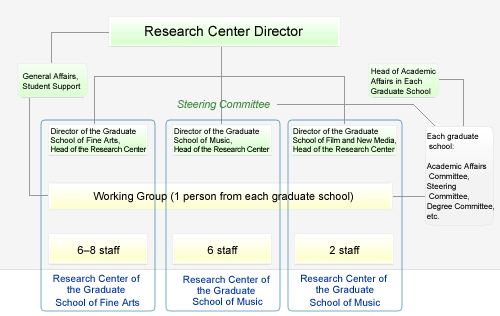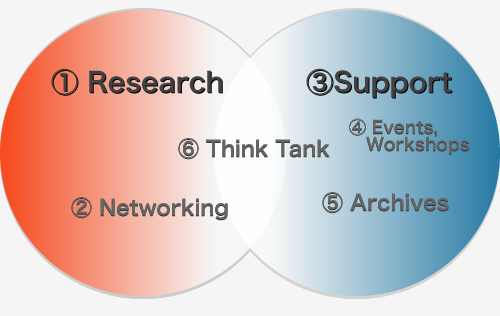About Research Center
1. Overview
The Research Center for Graduate Schools was established in 2008 in order to conduct a five-year study of practice-based doctoral programs in the arts (practical fields such as art and music), which was funded by a Special Funds for Education and Research grant from the Ministry of Education, Culture, Sports, Science, and Technology (MEXT). Since then, the center has reviewed numerous doctoral programs in Japan and overseas, and examined their degree conferral processes as well as supervisory and assessment systems. In particular, it has extensively investigated potential of integrating artistic practice into research dissertation writing. As a part of this research, the center has provided students in practice-based doctoral programs with technical support for dissertation writing and new methods for presenting research outcomes.
2. Background
The university established its doctoral programs in 1977 and the first doctoral degrees were awarded in 1982 with steadily increasing numbers during the subsequent years. However, when the MEXT revised the criteria for establishing graduate schools and presented its policies on graduate school education in 1991, there was a marked increase in the enrollment of doctoral programs. Although the university improved its graduate school administration in order to cope with this increase, more drastic measures were necessary. Therefore, the Research Center for Graduate Schools was established in 2008 to examine and conduct research on practice-based doctoral programs.
3. Organization
As shown in Fig. 1, the Research Center for Graduate Schools consists of the Research Center for the Graduate School of Fine Arts and the Research Center for the Graduate School of Music, which are both overseen by the Research Center Director. In 2010, the Research Center for the Graduate School of Film and New Media was added. Since the beginning of the project, the steering committee has decided the policies and overseen its administration. In 2011, a working group was established to handle operational matters across the three gradate schools, which comprised of each of the graduate schools in the research center. The number of staff members in each graduate school, who were actually in charge of conducting research and providing student support, was determined according to the size of each doctoral course of study.
4. Overview of Initiatives
As shown in Fig. 2, there are two overall initiatives for the Research Center of Graduate Schools: research and support. Research means conducting major studies on doctoral programs in the field of the arts in Japan and overseas as well as examining previous doctoral research completed at the Tokyo University of the Arts. Support includes individual dissertation writing support as well as technical support seminars and other related activities. The “ Doctoral Program Exhibition ” and “ D-Concerts ” have also been held in order to explore new ways to present research results to the society. For more details on the main initiatives of the Research Center of Graduate Schools, please see Table 1.
Fig. 1. Organizational Chart

Fig. 2. Main Roles of the Research Center of Graduate Schools

Table 1. Main Project Activities of the Research Center of Graduate Schools
| Graduate School of Fine Arts | Graduate School of Music | ||
|---|---|---|---|
| 1) Research and 2) Networking |
Overseas | United Kingdom: University of the Arts London France: Ecole des Beaux-Arts Czech: Brno University of Technology Sweden: Malmo Art Academy, Lund University USA: University of California, San Diego; Pennsylvania State University; IDSVA; NYU Steinhardt School Australia: University of Melbourne China: Tsinghua University Academy of Arts & Design; Central Academy of Fine Arts |
United Kingdom: Royal Academy of Music; Royal College of Music; Royal Welsh College of Music & Drama; University of London; University of Cambridge France: Conservatoire de Paris Hungary: Franz Liszt Academy of Music Finland: Sibelius Academy Russia: Moscow Conservatory; Moscow State University, Faculty of Fine and Performing Arts Singapore: Yong Siew Toh Conservatory of Music |
| Japan | Aichi Prefectural University of Fine Arts and Music; Osaka University of Arts; Kanazawa College of Art; Kyoto City University of Arts; Kyoto University of Art and Design, Kurashiki University of Science and the Arts; Joshibi University of Art and Design; Tama Art University; Tohoku University of Art & Design; Nihon University; Hiroshima City University; Musashino Art University |
Aichi Prefectural University of Fine Arts and Music; Elisabeth University of Music; Osaka University of Arts; Kyoto City University of Arts; Kunitachi College of Music; Seitoku University; Musashino Academia Musicae | |
| On Campus | Faculty member questionnaire; Survey on educational effectiveness; Questionnaire for students using services; Survey on post-PhD activities |
Faculty member questionnaire; Faculty member interviews; Study of previous dissertations |
|
| 3) Support | Special lectures on essay writing techniques (first year); Essay writing techniques exercises (second year); Individual essay writing techniques coaching (final year); Interim presentation of essay (second year) |
Individual student support (all years, but mostly during the dissertation submission year); Information exchange meeting (start of the year); Interim presentation (July); Research exchange (January) |
|
| 4) Events, workshops | Doctoral program exhibition (and book); Discussion group meetings; Lecture meetings; Workshops |
Doctoral recital (and recording); Discussion group meetings; Symposium: “Performance/Creation & Artistic Research” Open lectures; D-Concerts (three times) |
|
| 5) Archives | Creating a database for previous doctoral research; Collaborating with the Art Archive Center |
||
| 6) Thinktank (working group) | Drafting practical-based doctoral programs in the arts; Editing the final report; Creating a website for the final report |
||




